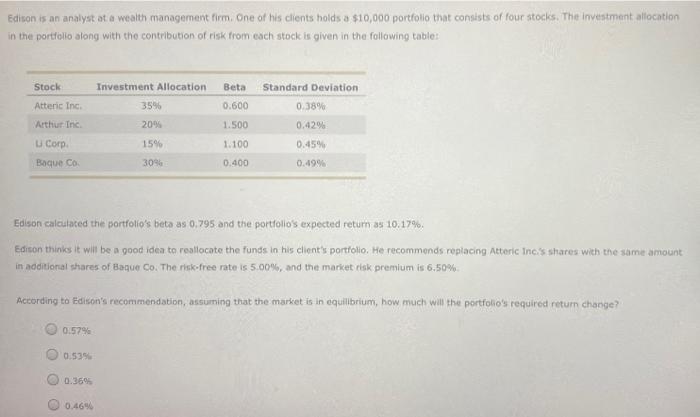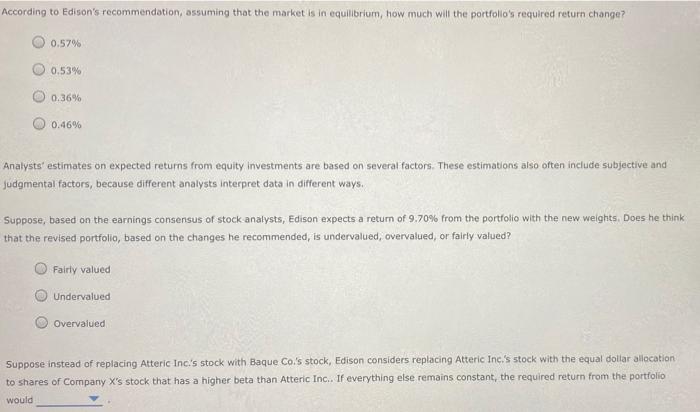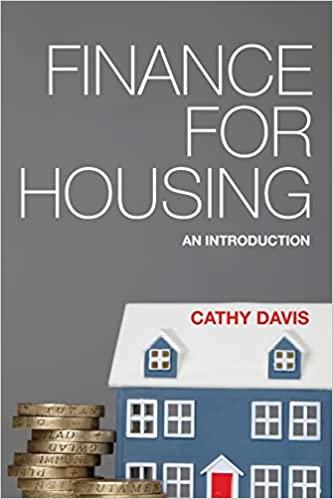Edison is an analyst at a wealth management firm. One of his clients holds a $10,000 portfolio that consists of four stoclos. The investment aliocation in the portiflio along with the contribution of risk from esch stock is given in the following table: Edison calculated the portfolio's beta as 0.795 and the portiolio's expected return as 10.17%. Edison thinics it will be a good idea to resliocate the funds in his client's portiolio. He recommends replacing Atteric incis shares with the same amount in additional thares of Bapue Co. The risk.free rate is 5.00%, and the market riak premium is 6.50%. According to Edison's recommendation, assuming that the market is in equilibrium, how much will the portfolio's repaired return change? 0.57% 0.5396 0.350% 0.46% According to Edison's recommendation, assuming that the market is in equilibrium, how much will the portfolio's required return change? 0.57%5 0.53% 0.36% 0.46% Analysts' estimates on expected returns from equity investments are based on several factors. These estimations also often include subjective and judgmental factors, because different analysts interpret data in different ways. Suppose, based on the earnings consensus of stock analysts, Edison expects a retum of 9.70% from the portfolio with the new weights, Does he think that the revised portfolio, based on the changes he recommended, is undervalued, overvalued, or fairly valued? Fairfy valued Undervalued Overvalued Suppose instead of replacing Atteric Incis stock with Baque Co.'s stock, Edison considers replacing Atteric Inc.'s stock with the equal doliar allocation to shares of Company X's stock that has a higher beta than Atteric Inc.. If everything else remains constant, the required return from the portfolio would suppo I replacing Atteric Incis stock with Baque Co,'s stock, Edison considers replacing Atteric Incis stock with the equal doliar allocation to sha sny X 's stock that has a higher beta than Atteric Inc. If everything else remains constant, the required return from the portfolio would Edison is an analyst at a wealth management firm. One of his clients holds a $10,000 portfolio that consists of four stoclos. The investment aliocation in the portiflio along with the contribution of risk from esch stock is given in the following table: Edison calculated the portfolio's beta as 0.795 and the portiolio's expected return as 10.17%. Edison thinics it will be a good idea to resliocate the funds in his client's portiolio. He recommends replacing Atteric incis shares with the same amount in additional thares of Bapue Co. The risk.free rate is 5.00%, and the market riak premium is 6.50%. According to Edison's recommendation, assuming that the market is in equilibrium, how much will the portfolio's repaired return change? 0.57% 0.5396 0.350% 0.46% According to Edison's recommendation, assuming that the market is in equilibrium, how much will the portfolio's required return change? 0.57%5 0.53% 0.36% 0.46% Analysts' estimates on expected returns from equity investments are based on several factors. These estimations also often include subjective and judgmental factors, because different analysts interpret data in different ways. Suppose, based on the earnings consensus of stock analysts, Edison expects a retum of 9.70% from the portfolio with the new weights, Does he think that the revised portfolio, based on the changes he recommended, is undervalued, overvalued, or fairly valued? Fairfy valued Undervalued Overvalued Suppose instead of replacing Atteric Incis stock with Baque Co.'s stock, Edison considers replacing Atteric Inc.'s stock with the equal doliar allocation to shares of Company X's stock that has a higher beta than Atteric Inc.. If everything else remains constant, the required return from the portfolio would suppo I replacing Atteric Incis stock with Baque Co,'s stock, Edison considers replacing Atteric Incis stock with the equal doliar allocation to sha sny X 's stock that has a higher beta than Atteric Inc. If everything else remains constant, the required return from the portfolio would









